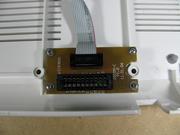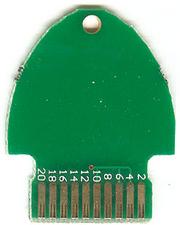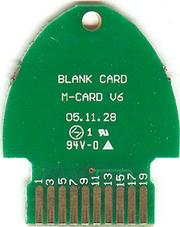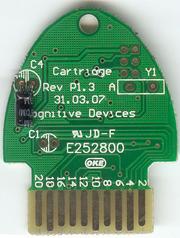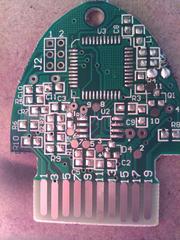Cricut Carts
From Cricut Hacking Wiki
The Cartridge Socket
The Cartridge socket isn't keyed, but it is mirrored so you can stick a cartridge in in either orientation and it will work just fine.
George and Basic Shapes
The "George and Basic Shapes" cartridge hack was one of the first Cricut hacks out there. This is the cartridge that comes with all new Cricuts is actually just a PCB with a few shorted pins, meaning that you can easily reproduce this cartridge by shorting a couple of the pins on the socket, or on the socket ribbon connector itself.
George and Shapes was the first Cricut cartridge and is actually a key to access the built in designs and not the cartridge. That's why it's so easy to create one. The remaining cartridges use an Atmel cartridge that specializes in encryption. All the designs are stored encrypted to make straight copies and dumps look like giberish. Bill D
Typical Cartridges
A typical cartridge ("Cricut Sampler" seen here) contains an ATmega16 and a 4-Mbit Flash part. There is a 6 pin .1″ header seems to be wired for in circuit serial programming:
| Header Pin | ATmega16 Pin |
|---|---|
| 1 | 2 – MISO |
| 2 | 5 – VCC |
| 3 | 3 – SCK |
| 4 | 1 – MOSI |
| 5 | 4 – RST |
| 6 | 6 – GND |
From the markings on the PCB, I would imagine that most cartridge hardware is identical. From a manufacturing perspective this is really smart. A single PCB design (Even if there are revisions) can be manufactured much cheaper in high quantities. When the PCB's arrive at the distribution center they can be programmed based on consumer demand, and just have a label applied.
The Cartridge PCB has the option of adding a Crystal and the complementary capacitors that would be required. Although these parts are not included by default. From the Lower left going up the left side the 4 and 5 from the bottom (Technically pins 7 & 8) on the surface mount component side they clearly go to two small pads (crystal footprint is actually on the backside of the PCB Y1) which then lead to C10 and C11 which are not populated then through a via to the ground plane on the backside of the board. End result is that the Microcontroller is using it's own internal oscillator.
"Provocraft" and the Cricut Personal, Cricut Expression, Cricut Cake, Cricut Mini and all other Provocraft devices and software mentioned here, and their logos are proprietary trademarks of Provocraft. Other trademarks seen on this site are the property of their respective owners. These trademark holders are not affiliated with www.built-to-spec.com/cricutwiki. They do not sponsor or endorse our research or any of our content. All rights are reserved. www.built-to-spec.com is not responsible for any promises, representations or warranties, expressed or implied, relating to the use of this web site or any of it's content within the web site by third party organizations.
